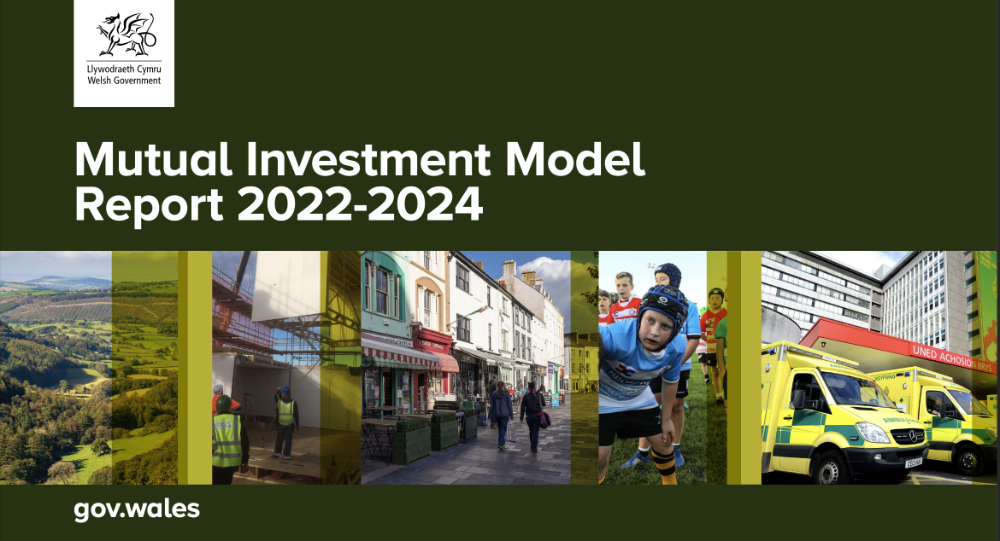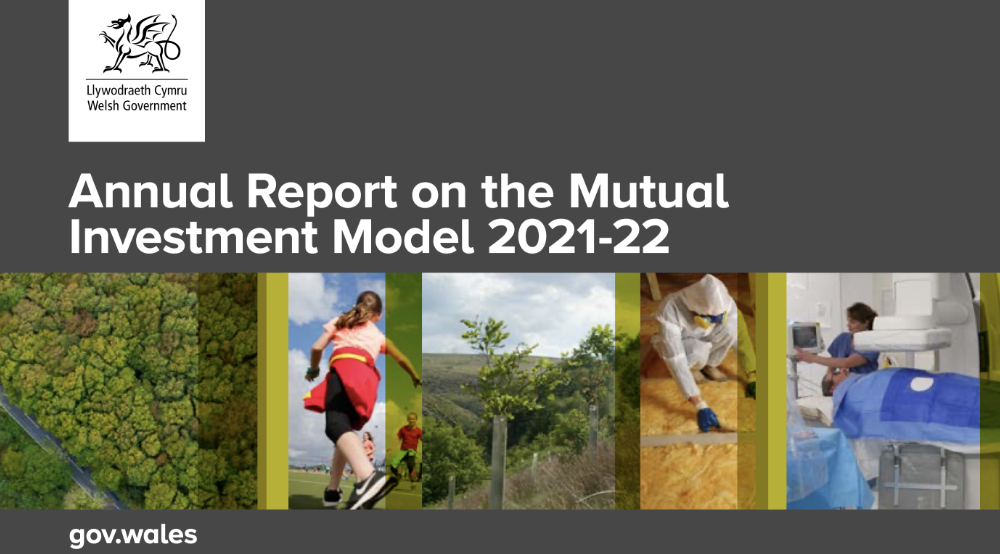Mutual Investment Models MIM
Contents |
[edit] Background to Mutual Investment Models in Wales
Mutual Investment Models (MIM) were designed by the Welsh Government, and initially launched in 2017 as a mechanism to finance major capital projects where there is a scarcity of capital funding. They may be considered in a category of public / private investment models along with Public Private Partnerships (PPP) and Private Finance Initiatives (PFI), but have elements that differ.
MIM aims to improve public services by financing major public projects and supporting additional investment in social and economic infrastructure, it differs from traditional PPP/PFI by removing elements that do not promote the public interest whilst maintaining elements of best practice.
The first MIM report was published by the Welsh Government in July 2022 and described their activities over the period June 2021 to June 2022.
The second Mutual Investment Model Report 2022-2024 (see top image) was published in May 2024, both reports highlight a number of different characteristics of Mutual Investment Models (MIM) along with examples of use in current projects in Wales.
[edit] Mutual Investment Models as enhancements
The key elements of PPP/PFI which have been enhanced in the MIM are outlined and described in the above reports as:
- "optimum risk allocation, whole-life costing, and performance-based payments – while ensuring that new investment is classified to the private sector
- private partners being obliged to help deliver the objectives of the Well-being of Future Generations (Wales) Act 2015 – including a focus on long-term sustainability and environmental efficiency
- financial and contractual remedies for non-delivery of stretching community benefits
- a mandatory commitment to the Welsh Government’s ethical employment code
- value for money as a core objective
- excluding provision for soft services (e.g. cleaning and catering) and capital equipment (e.g. specialist equipment for medical facilities), which led to expensive and inflexible contracts in the traditional PPP/ PFI model
- the public sector investing a small amount of risk capital in each scheme, ensuring a participation in any return on investment; and the appointment of a public sector nominated director to manage the public shareholdings
- a commitment to transparency, of which this Report forms a part."
[edit] MIM project delivery that promotes public interest
The Welsh Government describe two methods of delivery for MIM portfolio projects:
- Direct delivery: Where a single special purpose vehicle (SPV) is formed to deliver a specific project under a public private partnership ‘design, build, finance, maintenance and lifecycle’ contract known as the Project Agreement. This is suitable where the public sector is looking to procure a single high value asset.
- Strategic Partnership: An appointed single strategic partner delivers several assets for a range of authorities. The SPV delivers partnering services to the authorities. The strategic partner supports the delivery of a pipeline of MIM projects, and each authority enters into a project agreement for the delivery of its asset.
The public interest benefits described by the Welsh Government in the report include:
- Community Benefits: Private partners support contract authorities to achieve Wellbeing of Future Generations Act goals: job creation, training, apprenticeships, school engagement, and community initiatives. Promote supply chain support for SMEs and social enterprises, where non-compliance may result in financial penalties.
- Ethical Employment: Partners adhere to the Welsh Government’s Code on Ethical Employment, promoting fair work and sustainability within projects.
- Improving Value for Money: The MIM model optimises value by excluding capital equipment and facility management services from projects, allowing direct public funding for these.
- Public Sector Nominated Director: A public sector-nominated director on the SPV board ensures public interests in decision-making.
For further information about current Welsh Government MIM projects se Mutual Investment Model Report 2022-2024
[edit] Related articles on Designing Buildings
- Availability payments.
- Build lease transfer BLT.
- Build operate transfer BOT.
- Build, own, operate and transfer (BOOT).
- Concession agreement.
- Crown build.
- Design, build, finance, maintain DBFM.
- Design Build Finance Operate Maintain DBFOM.
- Design build finance transfer (DBFT).
- Design build operate (DBO).
- Design build operate transfer DBOT.
- Design construct manage finance DCMF.
- Flexibility in PPP Contracts: Best practices from countries where Abertis operates.
- Government Construction Strategy.
- Major Projects Authority.
- Midland Expressway Ltd v Carillion Construction Ltd & Others.
- PF2 (successor to PFI).
- Partnership.
- PPP unit.
- Pre-Contract Services Agreement.
- Private developer scheme.
- Private Finance Initiative.
- Private sector.
- Procurement route.
- Public private partnerships PPP.
- Public procurement.
Featured articles and news
One of the most impressive Victorian architects. Book review.
RTPI leader to become new CIOB Chief Executive Officer
Dr Victoria Hills MRTPI, FICE to take over after Caroline Gumble’s departure.
Social and affordable housing, a long term plan for delivery
The “Delivering a Decade of Renewal for Social and Affordable Housing” strategy sets out future path.
A change to adoptive architecture
Effects of global weather warming on architectural detailing, material choice and human interaction.
The proposed publicly owned and backed subsidiary of Homes England, to facilitate new homes.
How big is the problem and what can we do to mitigate the effects?
Overheating guidance and tools for building designers
A number of cool guides to help with the heat.
The UK's Modern Industrial Strategy: A 10 year plan
Previous consultation criticism, current key elements and general support with some persisting reservations.
Building Safety Regulator reforms
New roles, new staff and a new fast track service pave the way for a single construction regulator.
Architectural Technologist CPDs and Communications
CIAT CPD… and how you can do it!
Cooling centres and cool spaces
Managing extreme heat in cities by directing the public to places for heat stress relief and water sources.
Winter gardens: A brief history and warm variations
Extending the season with glass in different forms and terms.
Restoring Great Yarmouth's Winter Gardens
Transforming one of the least sustainable constructions imaginable.
Construction Skills Mission Board launch sector drive
Newly formed government and industry collaboration set strategy for recruiting an additional 100,000 construction workers a year.
New Architects Code comes into effect in September 2025
ARB Architects Code of Conduct and Practice available with ongoing consultation regarding guidance.
Welsh Skills Body (Medr) launches ambitious plan
The new skills body brings together funding and regulation of tertiary education and research for the devolved nation.
Paul Gandy FCIOB announced as next CIOB President
Former Tilbury Douglas CEO takes helm.
























